AUDI TT ROADSTER 2014 Owners Manual
Manufacturer: AUDI, Model Year: 2014, Model line: TT ROADSTER, Model: AUDI TT ROADSTER 2014Pages: 244, PDF Size: 60.87 MB
Page 191 of 244
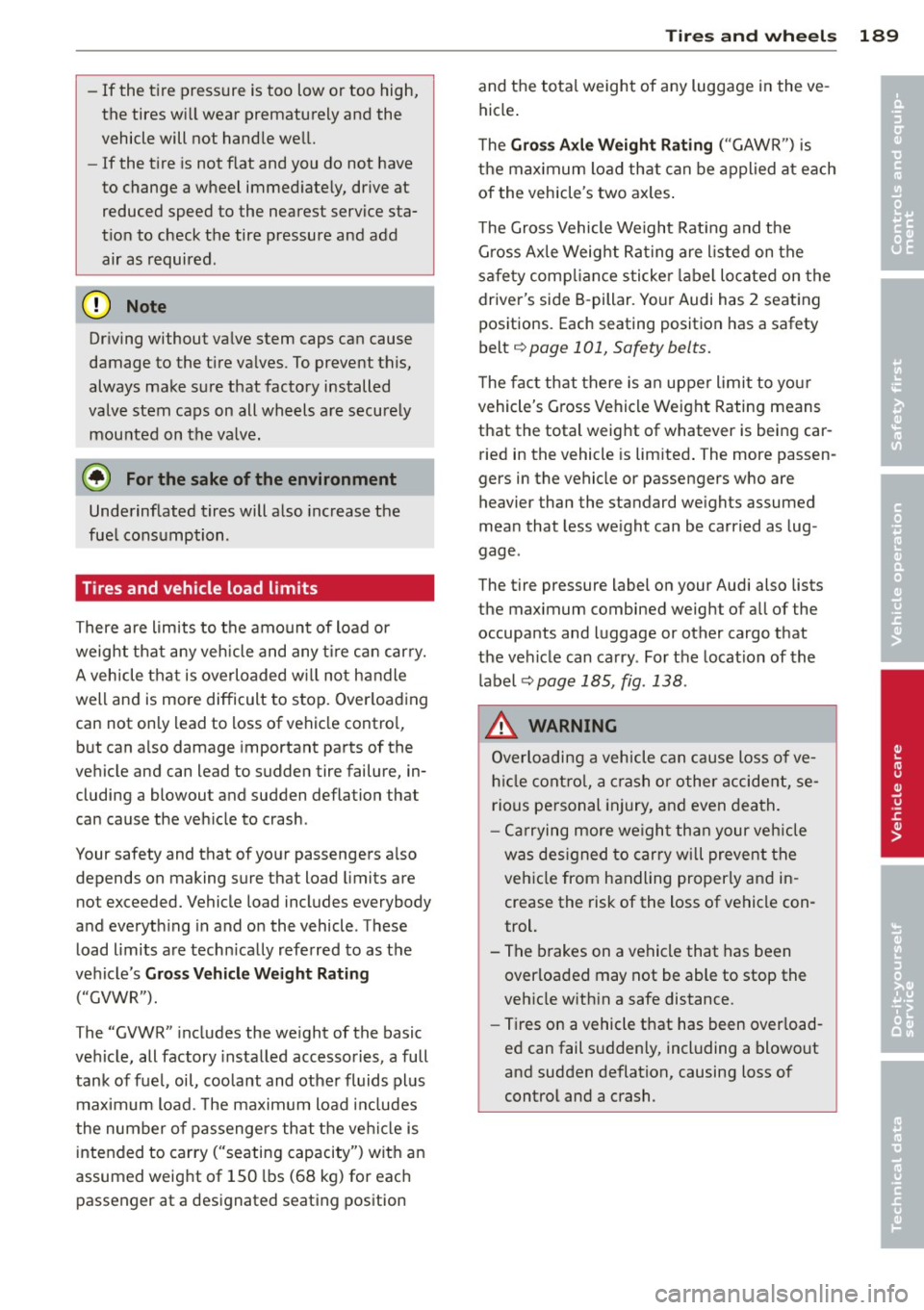
-If the tire pressure is too low or too high,
the tires w ill wear prematurely and the
vehicle will not handle we ll.
- If the tire is not flat and you do not have
to change a wheel immed iate ly, drive at
reduced speed to the nearest service sta
t ion to check the tire pressure and add
air as required.
([) Note
Driving without va lve stem caps ca n cause
damage to the tire va lves . To prevent this ,
always make su re that facto ry installed
valve stem caps on all wheels a re secure ly
mounted on the va lve.
@ For the sake of the environment
Underinflated tires will a lso increase the
fue l consumption .
Tires and vehicle load limits
There are limits to t he amount of load or
weight that any veh icle and any t ire can carry.
A veh icle that is overloaded w ill no t handle
well and is more diff icult to stop. Overloading
can not on ly lead to loss of veh icle contro l,
but can a lso damage important parts of the
ve hicle and can lead to sudden tire failure, in
cluding a blowout and sudden deflation that
can cause the veh icle to crash .
Your safety and that of yo ur passengers a lso
depends on making sure that load limits are
no t exceeded. Vehicle load includes everybody
and everyth ing in and on the vehicle . These
load limits a re techn ica lly refer red to as the
ve hicle's
Gro ss Vehicl e W eight Rat ing
(" GVWR ").
T he "GVWR " includes the we ight of the basic
vehicle, all factory installed accesso ries , a full
tank of fue l, oil, coo lant and other fluids pl us
maximum load. The maximum load includes
the number of passengers th at the ve hicl e is
i ntended to carry ("seating capacity") with an
assumed weight of 150 lbs (68 kg) for eac h
passenger at a designated seating position
Tire s an d wheel s 189
and the total weight of any luggage i n the ve
hicle .
T he
Gro ss Ax le Weight Rating ( " G AWR ") is
the max imum load th at can be applied at each
of the vehicle's two axles .
T he Gross Vehicle Weight Rat ing and the
G ross Ax le Weig ht Ra ting are l iste d on the
s af ety comp liance s ticke r label lo cated on the
driver's side 8-pillar . Your Audi has 2 seating
positions. Each seating position has a safety
belt ~
page 101, Safety belts.
The fac t that there is an upper limit to yo ur
vehicle's G ross Vehicle Weight Rating means
that the total weight of whatever is being car ried in the vehicle is lim ited . The more passen
gers in the vehicle or passengers who are
heavier than the standard we ights assumed
mea n that less we ight can be carried as lug
gage .
The tire pressure label on your Audi also lists
the maximum combined weight of a ll of the
occupants and luggage or other cargo that
t h e ve hicle can ca rry . Fo r th e locat ion of the
label
~ page 185, fig . 138 .
_&. WARNING
Overloading a veh icle can cause loss of ve
h icl e co ntro l, a crash or o ther accide nt, se
rio us pe rsonal inj ury, and even dea th.
- Ca rrying more we igh t tha n your ve hicle
was des igned to carry wi ll prevent the
veh icle from handling properly an d in
crease the risk of the loss of vehicle con
trol.
- T he b rakes on a vehicle that has been
overloaded may not be able to stop the
veh icle w ith in a safe distance .
- Tires on a vehicle that has been over load
ed can fail suddenly, incl uding a blowo ut
and sudden deflation, causing loss of
control and a crash.
•
•
Page 192 of 244
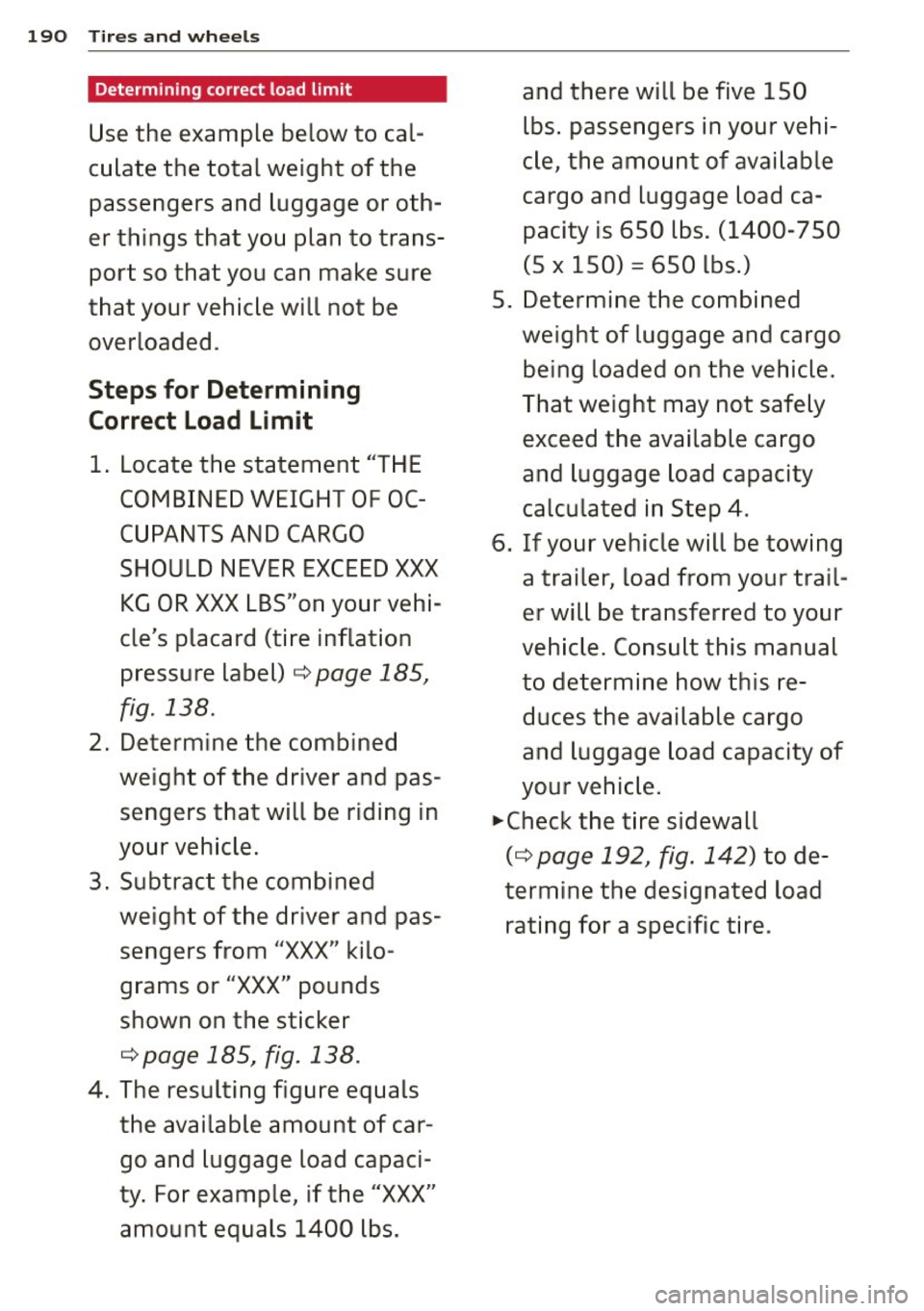
190 Tires and wheels
Determining correct load limit
Use the example below to cal
culate the total weight of the
passengers and luggage or oth
er things that you plan to trans
port so that you can make sure
that your vehicle will not be overloaded.
Steps for Determining
Correct Load Lim it
1 . Locate the statement "THE
COMB INED W EIGHT OF OC
CUPANTS AND CARGO
SHOULD NEVER EXCEED XXX KG OR XXX LBS"on your vehi
cle's placard (tire inflation
pressure label) ¢
page 185,
fig. 138.
2.
Determ ine the comb ined
weight of the driver and pas
sengers that will be riding in
your vehicle .
3. Subtract the combined weight of the dr iver and pas
sengers from
"XXX " kilo
grams or
"XXX" pounds
shown on the sticker
¢ page 185, fig . 138 .
4. The resulting figure equals
the available amount of cargo and luggage load capaci
ty . F or examp le, if the "XXX"
amount equals 1400 lbs. and there will be five 150
lbs . passengers in your vehi
cle, the amount of available
cargo and luggage load ca pacity is 650 lbs . (1400 -750
(5
X 150) = 650 lbs .)
5 . D etermine the combined
weight of luggage and cargo be ing loaded on the vehicle.
That we ight may not safely
exceed the available cargo
and luggage load capacity
calculated in Step
4 .
6. If your vehicle will be towing
a trailer, load from your trail
er will be transferred to your
vehicle . Consult this manual
to determine how this re
duces the available cargo
and luggage load capacity of
your vehic le .
... Chec k the tire sidewall
(¢ page 192, fig. 142) to de
termine the designated load rating for a specific tire .
Page 193 of 244
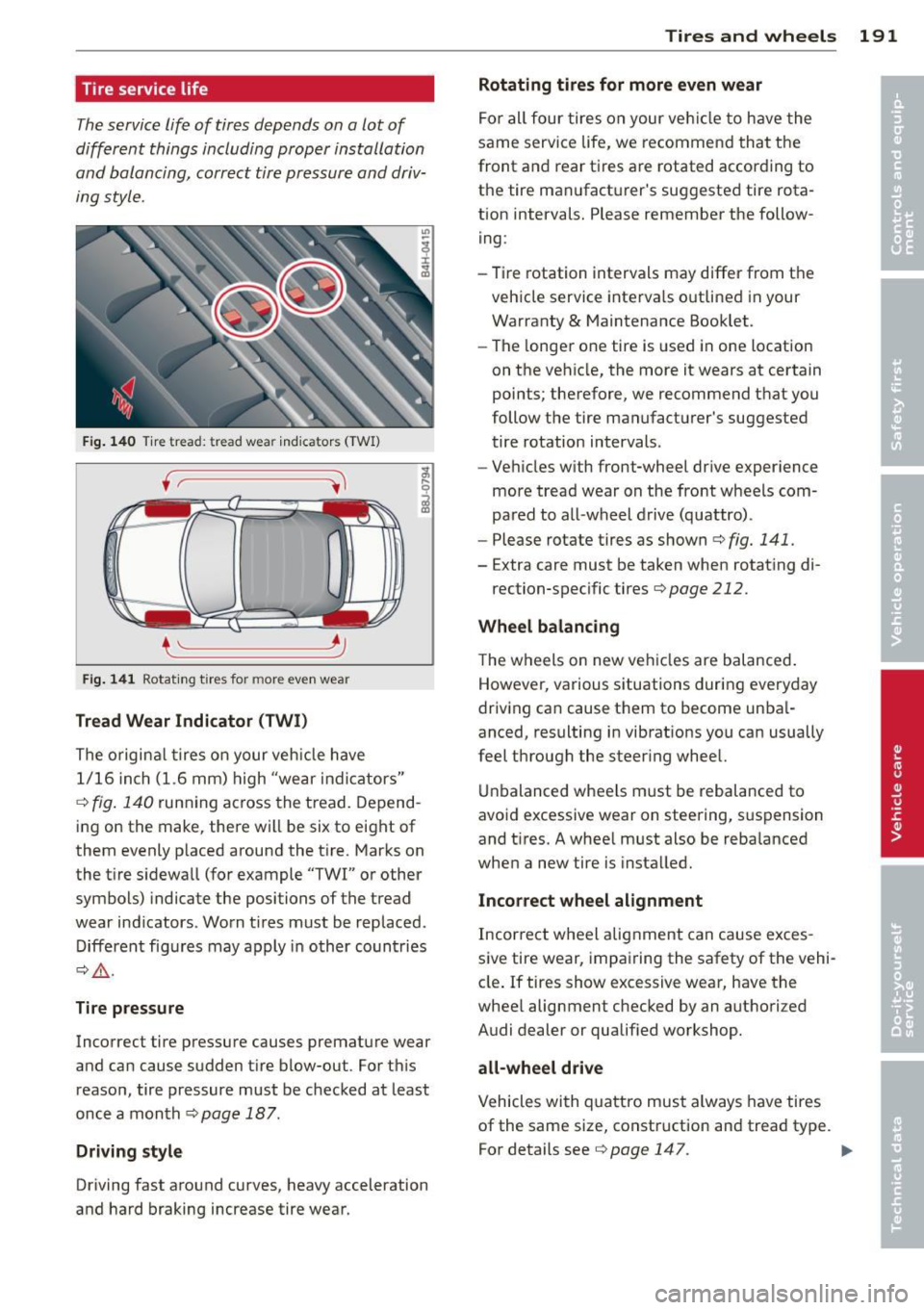
Tire service life
The service life of tires depends on a lot of
different things including proper installation
and balancing, correct tire pressure and driv
ing style.
F ig. 14 0 Tire tread: tread wea r ind ica tors (TWI)
f ~----~
~ ------- .../
Fig. 141 Rotat ing t ires fo r m ore even wea r
Tread Wear Indicator (TWI)
The origina l tires on your veh icle have
1/16 in ch (1.6 mm) high "wear ind icators"
c::> fig . 140 run ning across the tread. Depend
ing on the make, there will be six to eight of
them evenly p laced around the t ire . Marks on
the t ire s idewall (for example "TWI" or other
symbols) indicate the positions of the tread
wear ind icators . Worn t ires must be replaced.
Different fig ures may apply in other countries
c::> & .
Tir e pressure
Incorrect tire pressure causes premat ure wear
and can cause sudden tire blow-out . For th is
reason, tire pressure must be checked at least
once a month
c::> page 18 7.
Dri ving sty le
Driving fast around curves , heavy acceleration
and hard braking increase tire wear.
Tires and wheels 191
Rotating tires for more even wear
For all four tires on your ve hicl e to have the
same service life, we recomme nd that the
front and rear tires are rotated according to
the tire manufacturer 's suggested tire rota
tion inte rvals. Please remember the follow
ing :
- Tire rotation intervals may differ from the
veh icle service inte rva ls o utlined in your
Warranty & Maintenance Booklet.
- The longer one tire is used in one location
on the vehicle, the more it wears at certain
points ; therefore, we recommend that you
follow the tire manufactu rer 's suggested
tire rotation intervals .
- Vehicles w ith front-wheel dr ive exper ience
more tread wear on the front wheels com
pared to all -wheel d rive (quattro) .
- Please rotate tires as shown
c::> fig. 141.
-Extra care must be taken when rotat ing di-
rection-specific tires
c::> page 212.
Wheel balancing
T he wheels on new veh icles are balanced .
However, various situations during everyday
driving can cause them to become unba l
anced, resulting in vibrat ions you can usually
feel through the steer ing wheel.
Unbalanced wheels must be rebalanced to
avoid excessive wear on steering, s uspension
and t ires. A whee l must also be reba lanced
when a new tire is insta lled.
Inco rrect wheel alignm ent
Incorrect wheel alignment can cause exces
sive tire wear, impai ring the safety of the vehi
cle . If tires show excessive wear, have the
whee l alignment checked by an authori zed
Audi dealer or qualified workshop.
all -wheel drive
Vehicles wi th quattro must always have tires
of the same size, construction and tread type. For details see
c::> page 147.
Page 194 of 244
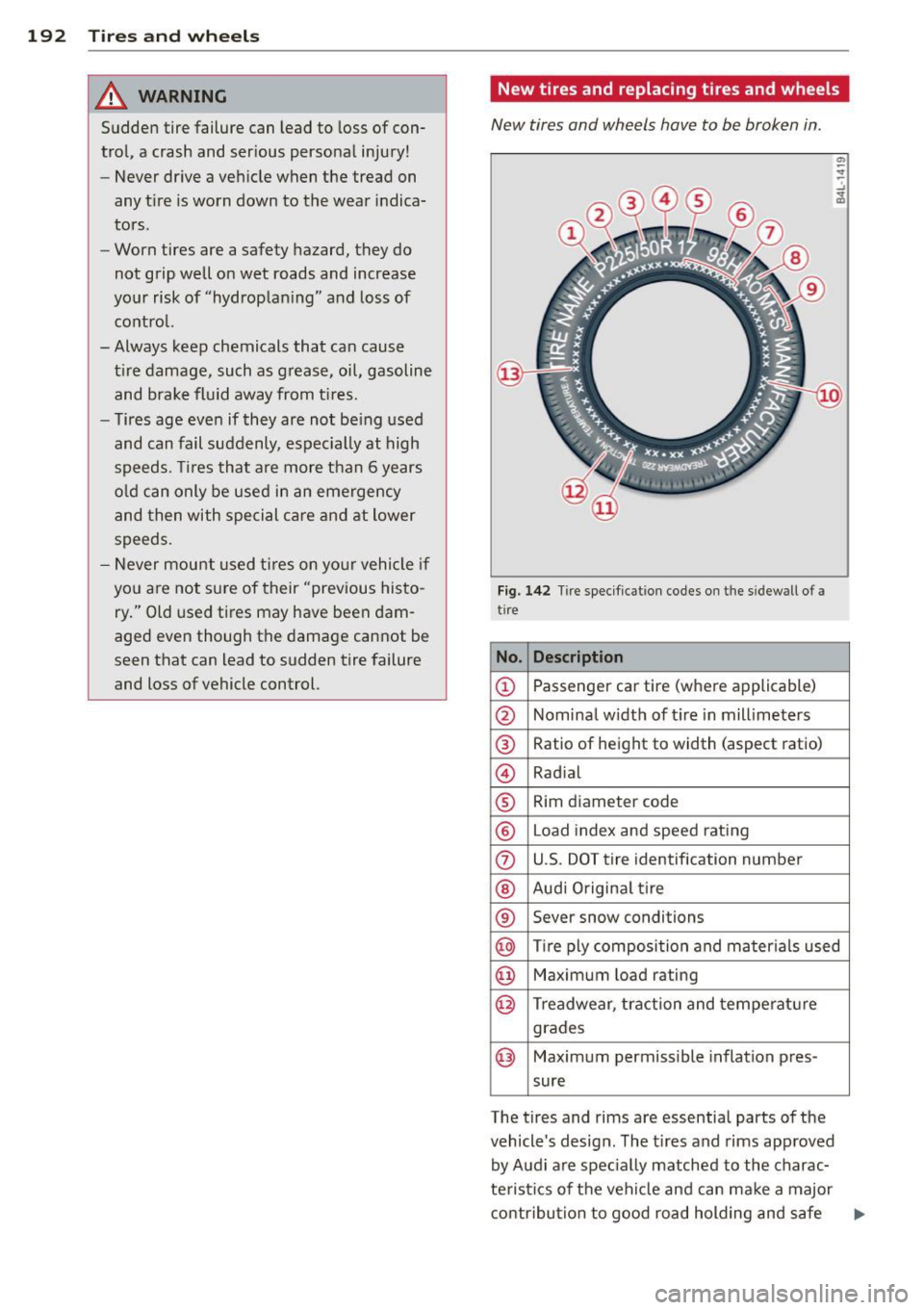
192 Tires and whe els
& WARNING
Sudden tire failure can lead to loss of con
trol, a crash and serious persona l injury!
- Never drive a vehicle when the tread on
any tire is worn down to the wear indica
tors .
- Worn tires are a safety hazard, they do
not grip well on wet roads and increase
yo ur risk of "hydroplan ing" and loss of
control.
- Always keep chemicals that can cause tire damage, such as grease, oil, gasoline and brake fluid away from t ires.
- Tires age even if they are not be ing used
and can fail suddenly , especially at high
speeds . T ir es that are more t han 6 years
o ld can only be used in an emergency
and then with special care and at lower
speeds.
- Never mount used ti res on yo ur vehicle if
yo u are not sure of their "previous histo
ry." Old used tires may have been dam
aged even though the damage cannot be
seen that can lead to sudden tire failure
and loss of vehicle control.
New tires and replacing tires and wheels
New tires and wheels have to be broken in .
Fig. 142 Tir e specificat ion codes on t he s idew all o f a
t ire
No. De scription
® Ratio of height to width (aspect ratio)
© Rad ial
® Rim diamete r code
® Load index and speed rating
(J) U.S . DOT tire ident ification number
® Aud i Origina l t ire
® Seve r snow cond it ions
@ T ire ply composi tion and mater ials used
@ Max imum load ra ting
@ Treadwear, traction and tempe rature
grades
@ Maximum permiss ible inflation pres -
sure
The tires and rim s are essential parts of the
vehicle's design . The t ires and rims app roved
by Audi a re spec ially matched to the charac
teristics of the vehicle and can make a major contribu tion to good road holding and safe .,..
Page 195 of 244

handling when in good condition and properly
inflated¢&..
We recommend that all wo rk on tires and
wheels be perfo rmed by an au thorized A udi
dea ler. They are familiar with recommended
proced ures and have the necessary special
too ls and spare parts as we ll as the proper fa
cilities for dispos ing of the old tires.
Authorized Audi dealers have the necessary information about technica l requirements for
insta lling or changing tires and r ims.
R eplacing t ire s an d wheel s
Tires s hou ld be rep laced at least in pairs and
not individua lly (for example both front t ires
or both rear tires together).
Be sure to read and heed the information to
the t ire pressure monitor ing system
¢page 199.
Always buy rep lacement radial tires that have
the same specifications as the tires approved
for your ve hicl e by Audi. Replacement t ires
must always have the same load rating speci
fication as the original equipment or approved optional tires listed in the table
¢ page 185.
Aud i-approved specifica tion ti res are specially
matched to you r vehicle and its load limits,
and can contribute to the important road ho ld
ing, driving characteristics, and safety of the
vehicle. The table
( q page 185) lists specifica
tions of the t ires approved for the Audi mod
e ls covered by your Owner's Literature .
The tire pressure labe l located on driver's side
B-pillar
( q page 185, fig. 139) lists the speci
fications of the orig inal equipment tires in
stalled on your veh icle at the time it was man
ufactured .
Federal law requires t ire manufacturers to
place standard ized information on the s ide
wall of all tires
q fig. 142. This information
ident ifies and describes the fundamental
characterist ics, the quality grade of the tire
and a lso provides a tire identificat ion number
for safety standard certificat ion and i n case of
a recall.
Tire s an d wheel s 193
Tire specification s
Knowledge of tire specifications makes it eas
ier to choose the co rrect tires. Radial tires
have the tire specifications marked on the
sidewa ll, for examp le:
P245 / 45 R 17 95 H
This conta ins the following information:
P Indicates the tire is for passenger cars
2 45 Nominal tire width in mm of the tire
from sidewall edge to sidewall edge. In general, the larger the number, the wider
the tire
45 Height/w idt h ratio in percent (aspect ra-
tio)
R Tire construction: Radial
17 Rim diameter code (in inches)
95 Load rating code
H Speed rat ing letter code
XL (or "xl", "EXTRA LOAD", or "RF") ind icates
that the t ire is a"Re inforced" o r an " Extra
Load " tir e
M+5 (or "M/S") Indicates that the tire has
some mud and snow capabi lity
The t ires could also have the informat ion of
direction of rotat ion
q page 181 .
Tire manuf acturing d ate
The manufacturing date is also indicated on
the tire sidewall (possibly on ly on the
inner
s ide of the wheel) :
"DOT ... 2213 ... "means, for examp le, that
the tire was produced in the 22nd week of
2013.
Sp eed rating (letter code )
The speed rating letter code on the whee ls in
dicates the maximum permissible road speeds
q .&. in Winter tires on page 197.
p up to 93 mp h (150 km/h)
Q up to 99 mp h (158 km/h)
R up to 106 mph (170 km/h)
s up to 110 mph (180 km/h)
T up to 118 mph (190 km/h)
u up to 124 mph (200 km/h)
H u
p to 130 mph (210 km/h)
•
•
Page 196 of 244
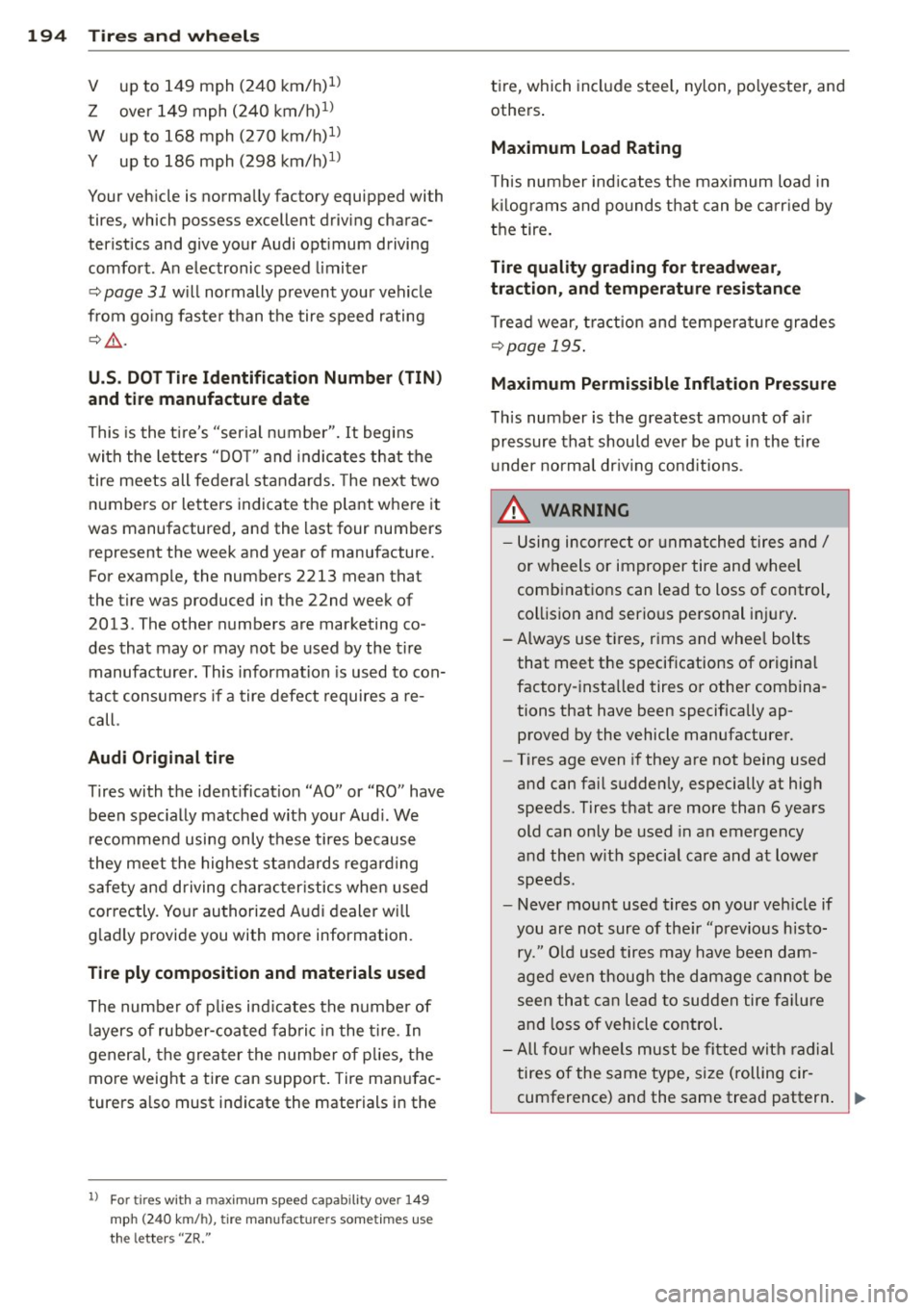
194 Tire s and wheel s
V up to 149 mph (240 km/h)l)
Z over 149 mph (240 km/h)ll
W up to 168 mph (270 km/h)ll
Y up to 186 mph (298 km/h)
1l
Your veh icle is norma lly factory equipped with
tires, which possess excellent driving charac
teristics and give your Audi opt imum driving
comfort. A n electronic speed limiter
~ page 31 w ill normally prevent your vehicle
from go ing faste r than t he tire speed rating
~ .&. .
U.S. DOT Tire Identification Number (TIN)
and tire manufacture date
This is the t ire's "serial number". It begins
wi th the le tte rs "DO T" and indica tes that the
tire meets all federal standards . The next two
numbers or letters indicate the p lant where it
was manufactured, and the last four numbers
represent the week and year of manufacture.
For example, the numbers 2213 mean that
the tire was produced in the 22nd week of
2013 . The other numbers are marketing co
des that may or may not be used by the tire
manufacturer. This information is used to con
tac t consume rs if a tire defect requires a re
call.
Audi Original tire
T ires with the ident ificat ion "AO" or "RO" have
been spec ially matched with your Aud i. We
recommend using only t hese tires because
they meet the highest standards rega rd ing
safety and d riving char acter istics when used
correctly . Your authorized Audi dealer will
g lad ly provide you with more information .
Tire ply composition and materials used
The numbe r of p lies ind icates the numbe r of
l ayers of rubber -coa ted fabric in the t ire. In
general, the grea ter the number of p lies, the
mo re weight a tire can support . Tire man ufac
turers a lso must indicate the materials in the
ll For tires wit h a ma xim um spee d ca pabil ity ove r 149
mph (2 40 km/ h), tire manufac tur ers somet imes use
t h e lett ers " ZR."
tir e, which include stee l, nylon, po lyester, and
others .
Maximum Load Rating
This number ind icates the maximum load in
k ilog rams and po unds t hat can be ca rr ied by
the tire .
Tire quality grading for treadwear ,
traction, and temperature resistance
T read wear, tra ct ion and tempera ture grades
~page 195 .
Maximum Permissible Inflation Pressure
This number is the greatest amount of a ir
pressure that should ever be put in the t ire
u nder norma l dr iv ing cond itions .
_& WARNING
- Using incorrect o r unm atc hed tires and/
or wheels or improper tire and wheel
combinat ions can lead to loss of control
'
collis ion and serio us personal i nju ry .
- A lways use t ires, rims and whee l bolts
that meet the specifications of original
factory- insta lled tires or other combina
tions that have been specifically ap proved by the vehicle manufacturer.
- Tires age even if they are not being used
and can fai l sudden ly, especially at hig h
speeds. Tires that are more than 6 yea rs
old can only be used in an emergency
and then w ith specia l care and at lower
speeds.
- Never mount used tires on your veh icle if
you are not sure of the ir "previo us histo
ry." O ld used tires may have been dam
a ged even thoug h the damage cannot be
seen that can lead to sud den tire fa ilure
and loss of vehicle control.
- All fo ur whee ls must be fitted with radial
tires of the same type, size (rolling cir
cumference) an d the same tread pattern . ..,
Page 197 of 244
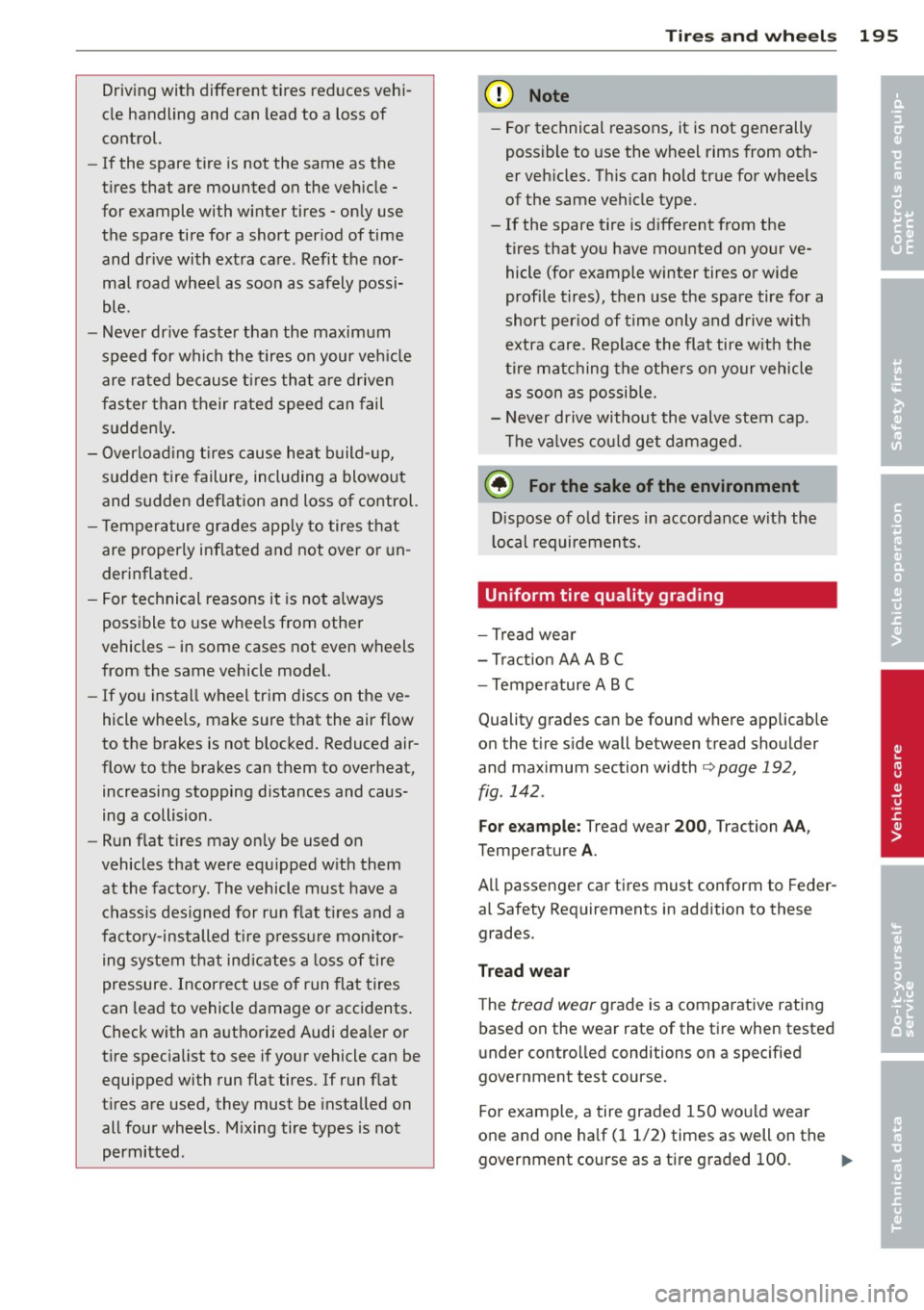
Driving with different tires reduces vehi
cle handling and can lead to a loss of
control.
- If the spare tire is not the same as the
tires that are mounted on the vehicle -
for example with winter tires -only use
the spare tire for a short period of time
and drive with extra care. Refit the nor
mal road wheel as soon as safely possi
ble.
- Never drive faster than the maximum
speed for which the tires on your vehicle
are rated because tires that are driven
faster than their rated speed can fail
suddenly.
- Overloading tires cause heat build-up,
sudden tire failure, including a blowout
and sudden deflation and loss of control.
- Temperature grades apply to tires that
are properly inflated and not over or un
deri nflated.
- For technical reasons it is not always
possible to use wheels from other
vehicles -in some cases not even wheels
from the same vehicle model.
- If you install wheel trim discs on the ve
hicle wheels, make sure that the air flow
to the brakes is not blocked. Reduced air
flow to the brakes can them to overheat, increasing stopping distances and caus
ing a collision.
- Run flat tires may only be used on
vehicles that were equipped with them
at the factory . The vehicle must have a
chassis designed for run flat tires and a
factory-installed tire pressure monitor ing system that indicates a loss of tire
pressure. Incorrect use of run flat tires
can lead to vehicle damage or accidents.
Check with an authorized Audi dealer or
tire specialist to see if your vehicle can be
equipped with run flat tires .
If run flat
tires are used, they must be installed on
all four wheels. Mixing tire types is not
permitted .
Tires and wheels 195
@ Note
-For technical reasons, it is not generally
possible to use the wheel rims from oth
er vehicles. This can hold true for wheels
of the same vehicle type.
- If the spare tire is different from the
tires that you have mounted on your ve
hicle (for example winter tires or wide
profile tires), then use the spare tire for a
short period of time only and drive with
extra care. Replace the flat tire with the
tire matching the others on your vehicle
as soon as possible.
- Never drive without the valve stem cap .
The valves could get damaged.
(® For the sake of the environment
Dispose of old tires in accordance with the
local requirements.
Uniform tire quality grading
- Tread wear
- Traction AA A B C
- Temperature ABC
Quality grades can be found where applicable
on the tire side wall between tread shoulder
and maximum section width
¢ page 192,
fig. 142 .
For example: Tread wear 200, Traction AA,
Temperature A.
All passenger car tires must conform to Feder
al Safety Requirements in addition to these
grades.
Tread wear
The tread wear grade is a comparative rating
based on the wear rate of the tire when tested
under controlled conditions on a specified
government test course.
For example, a tire graded 1S0 would wear
one and one half (1 1/2) times as well on the
government course as a tire graded 100. •
•
Page 198 of 244
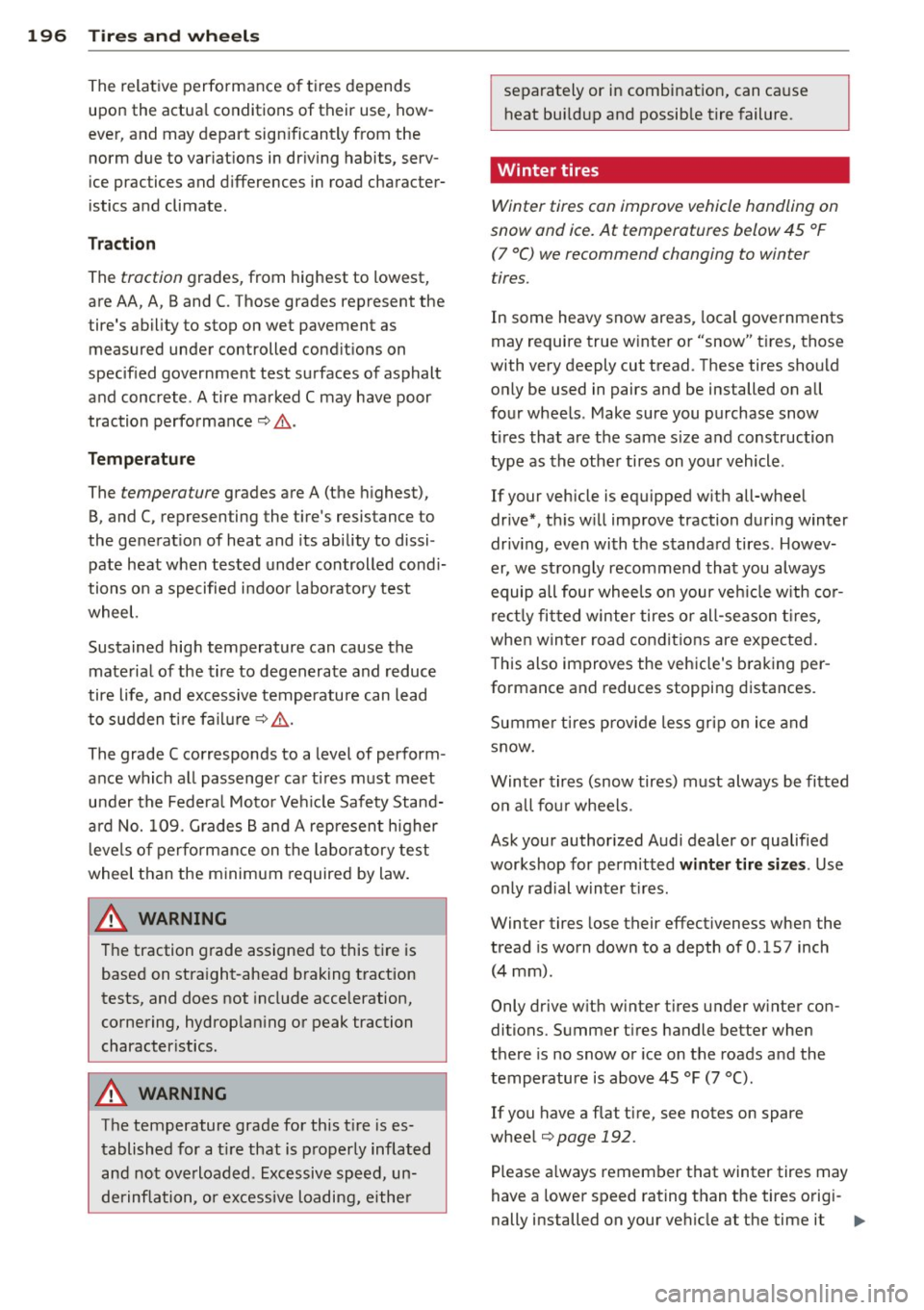
196 Tire s and wheel s
The relat ive performance of tires depends
upon the actua l conditions of their use, how
ever, and may depart sign ificantly from the
norm due to var iat ions in dr iving habits, serv
ice practices and differences in road character
istics and climate.
Tr action
The traction grades, from highest to lowest,
are AA, A, Band
C. Those grades represent the
tire's ability to stop on wet pavement as measured under controlled cond itions on
specified government test surfaces of asphalt
and concrete . A tire marked C may have poor
traction performance¢ .&,.
Temperature
The temperature grades are A (the h ighest),
B, and
C, representing the t ire's resistance to
the generat ion of heat and its abi lity to dissi
pate heat when tested under controlled cond i
tions on a specified indoor laboratory test
wheel.
Sustained high temperature can cause the
materia l of the tire to degenerate and reduce
tire life, and excessive temperature can lead
to sudden ti re fa il ur e~ .&, .
The grade
C corresponds to a level of perform
ance which all passenger ca r tires must meet
u nder the Federa l Moto r Veh icle Safety Stand
a rd No.
1 09. Grades Band A represent higher
l eve ls of performance on t he laboratory test
wheel than the minimum required by law .
.&_ WARNING
The traction grade assigned to this tire is
based on straight-ahead braking traction
tests, and does not include acceleration,
cornering , hydrop lan ing or peak traction
character istics.
.&_ WARNING
The temperature grade for this t ire is es
tablished for a t ire that is properly inflated
and not overloaded . Excessive speed, un
derinflation, or excessive loading, eithe r
-
separately or in combination, can ca use
heat bui ldup and possib le tire failure.
Winter tires
Winter tires can improve vehicle handling on
snow and ice. At temperatures below 45 °F (7 °C) we recommend changing to winter
tires.
In some heavy snow areas, local governments
may require true winter or "snow" tires, those
with very deeply cut tread . These tires should
only be used in pairs and be installed on all
four wheels . Make sure you purchase snow
tires that are the same s ize and construction
type as the othe r tires on your vehicle .
If your vehicle is equipped w ith all-whee l
drive", th is w ill improve traction during winter
driv ing, even with the standard tires . Howev
er, we st rongly recommend that you always
equip all fou r whee ls o n your ve hicle w ith cor
rect ly fit ted winter tires or all -season t ires,
when w inter road condit ions are expected.
T his also improves the vehicle's braking per
formance and reduces stopping distances.
Summe r tires provide less grip on i ce and
snow.
Winter tires (snow tires) must always be fitted on all four whee ls .
Ask your author ized Audi dealer or qualified
workshop for permitted
winter tir e siz es. Use
on ly rad ial winter t ires .
Winter tires lose their effectiveness when the
tread is worn down to a depth of
O .15 7 inch
(4 mm).
Only drive w ith w inter t ires under winter con
ditions. Summer t ires handle better when
there is no snow or ice on the roads and the
temperature is above 45 °F (7 °() .
If you have a flat ti re, see notes on spare
whee l
¢page 192.
Please a lways remember that winter tires may
have a lower speed rating than the tires origi -
nally installed on your vehicle at the time it .,.
Page 199 of 244
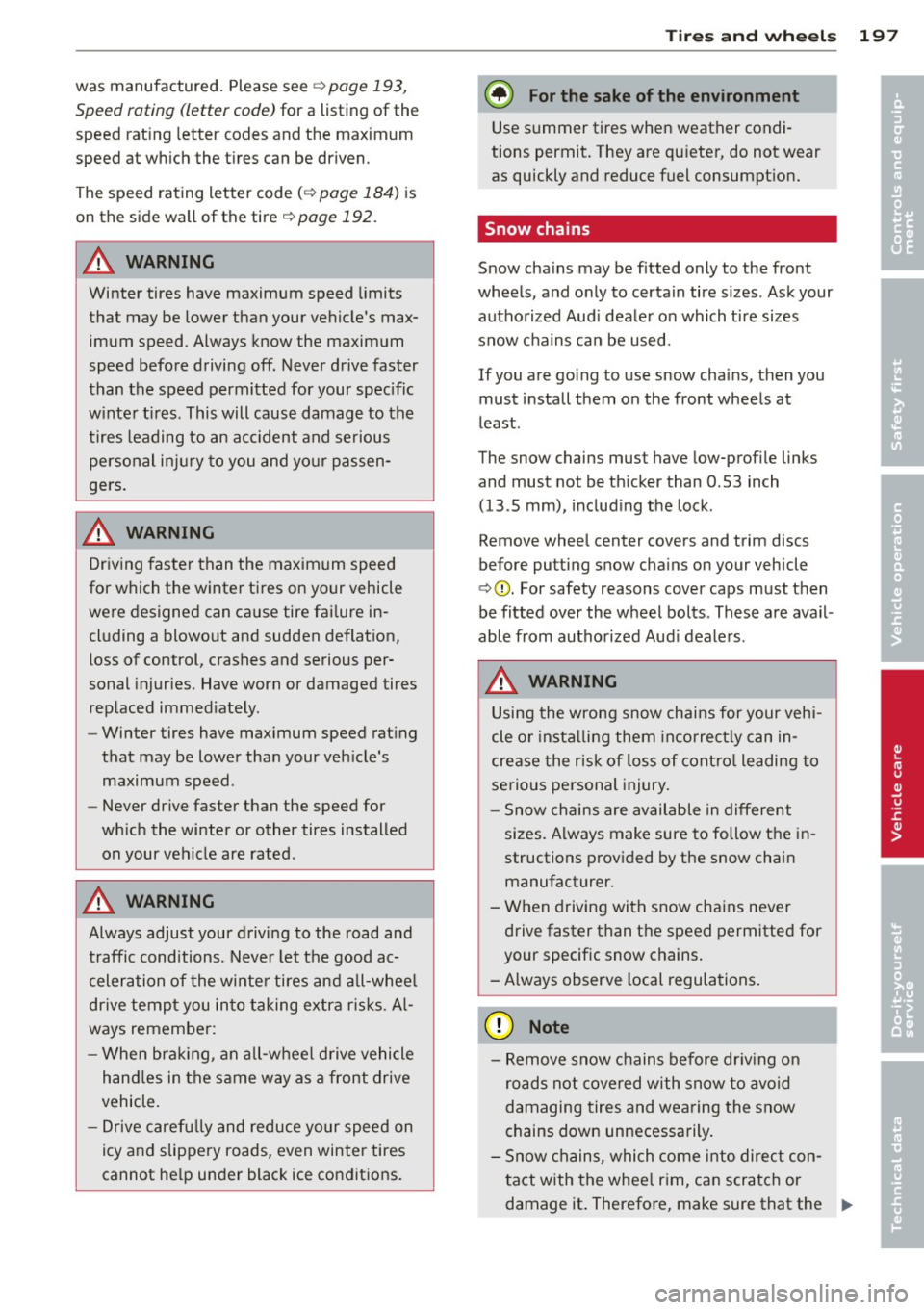
was manufactured. Please see c> page 193,
Speed rating (letter code)
for a listing of the
speed rat ing letter codes and the maximum
speed at which the tires can be driven .
The speed rating letter code
( c> page 184) is
on the side wall of the tire
c::> page 192 .
A WARNING
Winter tires have maximum speed limits
that may be lower than your vehicle's max
imum speed. Always know the maximum
speed before driving off . Never drive faster
than the speed permitted for your specific
w inte r tires . This will cause damage to the
tires leading to an acc ident and serious
personal injury to you and yo ur passen
gers .
A WARNING
Driving faster than the maximum speed
for which the winter tires on your vehicle
were designed can cause tire fai lure in
cluding a blowout and sudden deflation,
loss of control, crashes and serious per
sonal injuries . Have worn or damaged tires
replaced immed iately.
- Winter tires have maximum speed rat ing
that may be lower than your veh icle's
maximum speed .
- Never drive faster than the speed for
wh ich the winter or other tires installed
on your vehicle are rated .
A WARNING
Always adjust your driving to the road and
traffic conditions. Never let the good ac
celeration of the winte r tires and all-whee l
drive tempt you into taking extra r is k s . A l
ways remember:
- When brak ing, an a ll-wheel drive vehicle
hand les in the same way as a front drive
vehicle.
- Drive carefu lly and reduce your speed on
icy and slippery roads, even winter tires
cannot he lp under black ice conditions.
Tire s an d wheel s 197
@) For the sake of the env ironment
Use summer tires when weather condi
tions permit. They are quieter, do not wear
as quickly and reduce fuel consumption.
Snow chains
Snow cha ins may be fitted only to the front
wheels, and only to certain tire sizes . Ask your
authorized Aud i dealer on which tire sizes
snow chains can be used .
If you are go ing to use snow chains, then you
must install them on the front wheels at
least .
The snow chains mus t have low-prof ile links
and must not be th icker than 0 .53 inch
(13.5 mm), includ ing the lock.
Remove wheel center covers and trim discs
before putting snow chains on your vehicle
c::> (D . For safety reasons cover caps must then
be fitted over the wheel bolts . These are avail
able from authorized Aud i dealers.
A WARNING
Using the wrong snow chains for your vehi
cle or insta lling them incorrect ly can in
crease the risk of loss of cont ro l leading to
serious personal injury.
- Snow chains are available in different
sizes . Always make sure to follow the in
structions provided by the snow chain manufacturer .
- When driving with snow chains never drive faster than the speed permitted for
your specific snow chains.
- Always observe local regulations .
(D Note
-Remove snow chains before dr iv ing on
roads not covered with snow to avoid
damaging tires and wearing the snow
chains down unnecessarily.
- Snow chains, which come into direc t con
tact with the whee l rim, can scratch or
damage it . Therefore, make sure that the .,.
•
•
Page 200 of 244
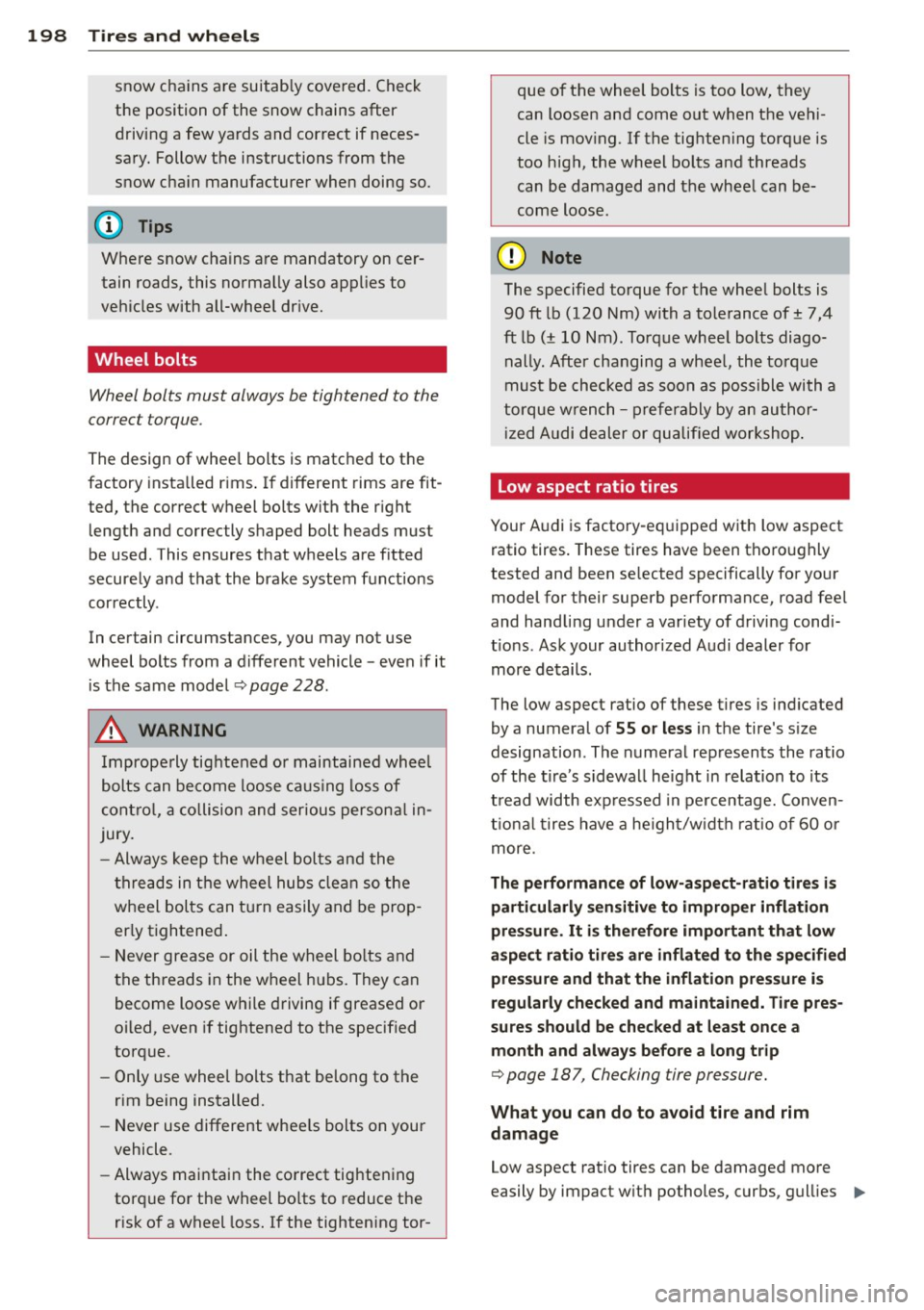
198 Tire s and wheel s
snow cha ins a re suitab ly covered. Check
the position of the snow chains after driving a few yards and correct if neces
sary. Follow the instr uctions from the
snow cha in manufacturer when doing so.
{O) Tips
Where snow cha ins are mandatory oncer
tain roads, this norma lly also applies to
veh icles with all-wheel dr ive.
Wheel bolts
Wheel bolts must always be tightened to the
correc t torque .
The design of whee l bolts is matched to the
factory installed r ims . If different rims are fit
ted, the correct wheel bolt s with the r ight
length and correctly shaped bol t heads mus t
be used . This ensures that wheel s are fitted
securely and that the brake system functions
correctly .
In certain circumstances, you may not use
wheel bolts from a d iffe rent vehicle -even if it
i s the same model
Q page 228.
A WARNING
Imprope rly tig htened o r maintained whee l
bolts can be come loose ca using loss of
cont ro l, a co llision and serious person al in
jury .
- Always keep the w heel bol ts and the
t h reads in t he wheel hubs clean so the
wheel bolts can t urn easily and be p rop
er ly t ightened .
- N ever grease or oil the wheel bo lt s an d
the threads in the wheel h ubs. They can
become loose w hile d riving if greased or
oi led, even if tightened to the specif ied
torque.
- Only use whee l bolts that be long to the
rim being installed.
- Never use different whee ls bolts on your
vehicle .
- Always mai ntai n the co rrect tighte ning
torq ue for the wheel bolts to reduce the
risk of a wheel loss. If the tightening tor- que of the whee
l bolts is too low, they
can loosen and come out when the vehi
cle is mov ing. If the tig hte ning torq ue is
too high, the w heel bolts a nd threads
can be damaged and the whee l can be
come loose.
(D Note
The specified torque for t he whee l bolts is
90 ft lb (120 Nm) with a tolerance of± 7,4
ft lb(± 10 Nm). Torque whee l bolts diago
nally . After changing a whee l, the to rq ue
must be checked as soon as possible with a
torque w rench - prefe rably by an author
iz ed A udi dealer or quali fied workshop .
Low aspect ratio tires
Your Audi is factory-eq uipped w ith low aspect
ratio tires. These tires have b een tho ro ughly
tested and been se lected specifically for your
model for their supe rb performance, road fee l
and hand ling under a variety of driving condi
t ions . Ask your author ized Audi dealer for
more de tails .
The low aspect ratio of these t ires is ind icated
by a numeral of
55 or less in the tire 's s ize
designation . The numera l rep resents the ratio
of the tire 's s idewa ll height in relation to its
t read width exp ressed in percentage. Conven
tiona l tire s have a he igh t/w idth rat io of 60 or
more.
The p erformance of low-a spect-ratio tire s is
particularly sensitiv e to improper inflation
pre ssure. It i s ther efore important that low
aspect ratio tires are inflated to the specified
pre ssure and that the inflation pre ssure i s
regularly checked and maintained. Tire pre s
sures should be checked at least once a month and always before a long trip
Q page 187, Checking tire pressure.
What you can do to avo id tire and rim
damage
Low aspect ratio tires can be damaged mo re
easily by impact w ith po tholes, curbs, gul lies ..,.